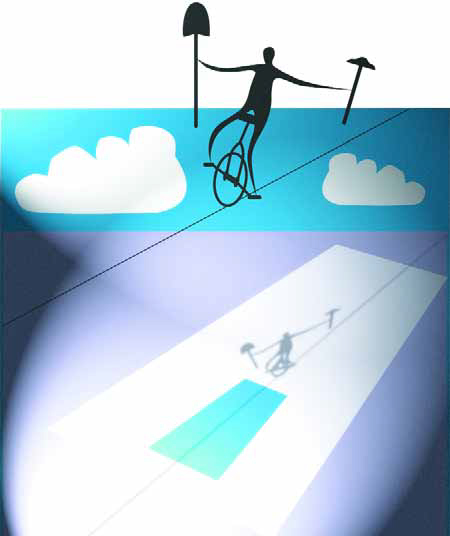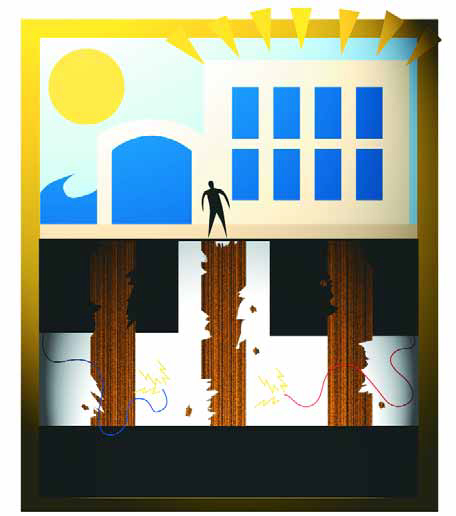construction
Since time immemorial, humans have sought out warm water for purposes of pleasure, bathing, relaxation and healing. That's a great thing for modern watershapers, almost all of whom are steadily asked to design swimming pools with attached spas or to set up stand-alone inground spas or to find ways to make portable spas work as part of a landscape or deck setting. I'd argue that hot water is even more important to contemporary lifestyles than it was to the Assyrians, Greeks or Romans of antiquity, given the stresses of modern life and the fact that we seem to have more of the leisure time required to enjoy a
Sometimes it's the small things that give a project its character and value. In the case of landscape design and installation at the Cross Valley Water District facility, we were able to take a relatively modest property and transform it into a demonstration campus that illustrates how man-made environments can be used to enhance the natural surroundings and meet the needs of human beings - and do it all with grace and harmony. I became involved in this project in June 1998, when I was approached by Brandt McCorkle, Lee Beard and Galen Page of Page & Beard Architects. That firm had been chosen to design the water district's new headquarters building and had developed a craftsman-style structure that blended perfectly with its rural, wooded surroundings. Set on five acres in Clearview, Wash., the district office serves
We live in a wonderful era of creative development in a variety of watershaping trades and are truly blessed, it seems, with an ever-expanding generation of talented artists and a sense that our most dynamic creations are yet to be built. For all of this forward momentum, however, I find myself surprised and dismayed all too often by the lack of creativity that goes into our work below the water's surface. To my eyes, pool and spa interiors in particular are simply bland and boring. I'm oppressed by six-inch waterline tile surmounting a field of
Change can be both exciting and terrifying. In my experience, the biggest changes often come with the potential for tremendous rewards, but also with significant risk. During the past two years, such change has come for our company in the form of an all-encompassing transformation that has involved every aspect of the way we do business. We've gone from trying to mass-produce affordable swimming pools and hardscape designs (and fighting for every dime we made along the way) to building only high-end, custom projects where we never compromise on quality - and make generous
Last time, I described a series of unfortunate revelations that complicated the early stages of an elaborate pool renovation project in Malibu, Calif. By the time all of those enormous structural issues had been addressed, the pool project had been on hold for about six months. When we finally returned to the site to resume our work, we were greeted by a "courtyard" that was basically a neat, seven-foot-deep hole surrounded by a beautiful home in one of the most exclusive neighborhoods in the country. Although the most significant of the troubles were now behind us, the tasks that followed were far from simple. In the intervening six months, my clients had
Vanishing-edge pools are all about changing the relationship of the water to its surroundings. They enable the water to reflect views and create visual links to the surrounding scenery in dramatic and surprising ways that simply can't be achieved with conventional designs. The same distinction is true of perimeter-overflow systems and pools with deck-level (or slot-overflow) designs, which is why I classify all three together as "water-in-transit" systems. There's a lot of diversity under that big conceptual umbrella, but these pools share
We've all heard and read how important it is to study the achievements of our predecessors in watershape design and engineering. Indeed, exploring these historic works is vital for the role it plays in emboldening our sense of artistic tradition and inspiring our creativity by offering rich galleries of design ideas. When considering Villa d'Este in such light - its extraordinary architecture, otherworldly gardens and daring watershape designs - it's easy to see why this grand estate is so important to us now. It's widely considered to be the most significant residence surviving from the Renaissance and has every right to claim to be the most beautiful and influential as well. Surely there's no substitute for traveling there and lingering with eyes wide open, but even from afar, we can and should turn to this amazing estate as a source of artistic inspiration and, in many respects, as a technical blueprint. A COMPREHENSIVE PROGRAM These days, most of us are more familiar with Bellagio than we are with Villa d'Este, upon which the spectacular Las Vegas hotel was patterned. Even with
Every once in a while, being right is not such a great thing! Last month in this column, I described the initial phases of a spectacular project in Malibu, Calif., and one of the things I mentioned was the fact that from the moment I stepped onto the site, I suspected that there might be some serious problems afoot. This impression was based largely on what I saw to be substandard construction of the existing swimming pool and on concerns about the elevation of the deck relative to the structure of the house. Unfortunately, those initial impressions turned out to be
If you can't see potential in every backyard you walk into, then you're in the wrong business. Yes, some projects are more inspiring than others, and some spaces seem to offer you more to work with than others. Without exception, however, our clients' yards present us with opportunities to develop programs that take advantage of what's there in ways that bring balance and harmony and interest to any setting. Speaking for myself, I'm no more energized in a project than when I get the opportunity to right a wrong and replace a past mistake with a fresh, interesting design - and that was certainly the case in the project discussed in this article and in my past several "Details" columns in this magazine. The setting was special, the clients were great and I was given free rein to work with color, shape and line in vivid, interesting and even startling ways - all in keeping with their wants and desires. SETTING THE SCENE To recap information from recent "Details," this pool/spa combination with its associated decking, walls, planters, outdoor cooking facilities and private garden area are located in a narrow yard at the base of a slope in Pacific Palisades, Calif. It's a spectacular
The Pacific Northwest is full of spectacular scenery. From where I live near the Puget Sound, for example, you can see the Olympic range running along a peninsula to the west and the Cascade range off to the east. Looking southeast, Mt. Rainier is a silent, majestic sentinel silhouetted against an ever-changing sky. It's a beautiful place to live and perfect when it comes to design inspiration - especially when your work is creating naturalistic gardens and watershapes. One of the most spectacular waterfalls in the entire northwest is just a short drive up Interstate 90 from me, a place called Snoqualmie Falls. Local hiking trails are dotted by scores of perennial waterfalls that cascade down mountainsides. For me, there is nothing more refreshing than clambering up a steep grade and rounding the corner to find a misty, shady waterfall. It invigorates the soul and encourages one and all to keep climbing in the hope of seeing even more spectacular scenery. The attractions of nature and its inherent beauty are much enjoyed by people who live around here. In recent years, I've seen a trend toward bringing slices of that grandeur down to a residential scale in gardens that use water in motion as a key feature. It's the water that






















